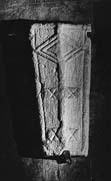Select a site alphabetically from the choices shown in the box below. Alternatively, browse sculptural examples using the Forward/Back buttons.
Chapters for this volume, along with copies of original in-text images, are available here.
Object type: Grave-cover
Measurements: L. 48.5 cm (19 in) W. 23 > 16 cm (9 > 6.3 in) D. 10.5 > 9 cm (4.1 > 3.5 in)
Stone type: Pale grey (10YR 7/1) shelly oolitic limestone, with closely set ooliths and (on the stone surface) vacant sockets of ooliths, mostly around 0.5 to 0.6mm in diameter (but with some patches of 0.4mm ooliths), together with sub-rounded 1mm pellets and 3mm shell fragments. Barnack Rag type, Upper Lincolnshire Limestone, Inferior Oolite Group
Plate numbers in printed volume: Ill. 143
Corpus volume reference: Vol 5 p. 146
(There may be more views or larger images available for this item. Click on the thumbnail image to view.)
A complete small tapered and coped grave-cover, decorated on the upper surface only.
A (top): The eaves are bordered by a roll moulding which is continuous around both head and foot ends. The central ridge is also defined by a broad roll moulding; joining this are three pair of 'arms' cut in low relief, each of which is symmetrical about the ridge. The uppermost, at the head end, consists of a pair of addorsed equilateral triangles which form a lozenge-shape across the ridge. Within the lozenge two more pairs of triangles are created by concentric incised lines. Above the lozenge, again symmetrically placed to left and right, are two lightly inscribed circles based on identifiable compass holes. The two lower arms are composed of pairs of rectangular fillets also in low relief and also symmetrical about the ridge. In the centre of each fillet a pair of incised diagonal lines form an X. These fillets are very similar to the 'bull's head' motifs which belong to the mid-Kesteven covers group (Fig. 11).
This monument belongs to a small group of late grave-covers decorated with lozenges in relief (Butler 1957). Although the cover at Whaplode (no. 2, Ill. 386) could be generally grouped with Crowland as having lozenge decoration, much closer parallels are provided by larger covers at Sleaford (no. 3, Ill. 429), at Waterbeach, Cambridgeshire, and the small cover, of similar size to Crowland, at Wood Walton, Huntingdonshire. There are also fragments from covers of this group at Barnack (reset in the fabric of the tower just to the west of the south door) and at Maxey (both Soke of Peterborough). The Cambridgeshire group of covers is ascribed by Butler to the late eleventh-century workshops associated with the Barnack quarries (Butler 1957; id. 1964, 118–21).
The Crowland cover is of a ragstone type very similar to the Barnack stone used in the other covers, and this suggests that it may also be a product of Butler's putative workshop there. Within this group only Crowland and Waterbeach do not have crosses of other types in addition to lozenges; instead the lozenge itself stands in, at the head of the stone, for the cross on both monuments. The fact that Crowland does not have a second cross-head may suggest that this is a relatively early member of the group; i.e. that it should be dated to the later eleventh century rather than to the early twelfth. All of the monuments in this group, however, also have additional decoration to the ridge rib, both in its centre and at its foot. The 'bull's heads' at Crowland cannot be exactly paralleled in the other Barnack monuments, although the rectangular panel across the centre of the Wood Walton stone is somewhat similar. The bull's head motif is only found elsewhere in Lincolnshire on the members of the mid-Kesteven cover group (Chapter V). The appearance of the motif at Crowland, on this late cover, must suggest that it lingered in use until the end of the eleventh century, and by this date had been taken up by production centres outside its original Ancaster source.



